Flag of the Kalmar Union

The flag of the Kalmar Union , also known as the flag of the north , was introduced by King Erik VII in 1430 at the latest as an imperial banner for ceremonial occasions and was intended to represent the union of the kingdoms of Denmark , Norway and Sweden .
The flag shows a red Scandinavian cross on a yellow background, shifted towards the flagpole . The cross that can be found today in almost all flags of the Nordic countries is probably taken from the Dannebrog , the flag of Denmark; the colors come from the Norwegian coat of arms .
history
The use of the flag is documented for the first time in writing in 1430, when it was attached to Queen Margaret I's sarcophagus . Her successor Erik VII determined that her cloak should wear "a red cross on a golden or yellow field that is the imperial banner" (It røt Kaars udi it gult Felt, som er Rigen's banner) . After the time of Erik VII, the use of the flag initially took a back seat.
The flag is used again today by supporters of Scandinavianism . Before the introduction of its current flag until 1985, the Nordic Council also demonstrated the traditional ties of the Nordic countries.
Similar flags
The former flag of the Orkney Islands , in use from the mid-1990s to 2007, corresponded to the flag of the Kalmar Union. However, it had no official status. Even the banner of arms of the Swedish church is similar to the flag.
See also
Web links
- Rigens banner - et nordisk flag History of the Kalmar Union and its flag ( Danish )
- North Flags of the World on the flag ( english )